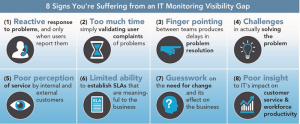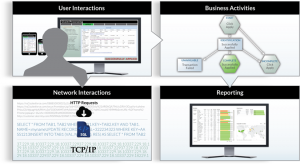End User Experience Monitoring
End User Experience Monitoring from the point of consumption – the user’s device
Close the IT monitoring Visibility Gap
If your IT monitoring tools show that everything is green, but your workforce is still complaining, you have an IT monitoring “Visibility Gap.” That’s the gap between what your domain-specific monitoring tools are telling you and what your users are experiencing. It exists because you can’t measure end user experience from the vantage point of the data center “looking out.” You can only measure it from the end user’s perspective “looking in.”

- Users and their locations: Automatic discovery of user attributes such as identity, role, department, office and geographic location, subnet, and VPN, enable you to immediately analyze the impact of performance on workforce productivity.
- Devices and their Operating Systems: Automatic discovery of key attributes of every physical, virtual, or mobile device, including make & model, number of cores, disks and shared drives, OS type, version & service pack, boot services, running processes, and the top processes consuming CPU, memory, and I/O resources. With this data, you can assess how performance is affected by device configurations.
- Applications, processes, and health indicators: Automatic discovery of all local, cloud, web, or instrumented mobile app running on any physical, virtual, or mobile device. Discovering applications actually in use, whether authorized by IT or not, enables you to combat Shadow IT.
Define business activities on your terms
Applications used by your workforce may be part of a single step, or part of a more complex user workflow, consisting of a sequence of business activities. Unlike APM products that primarily report application diagnostic data like SQL and code level execution times, URL response and page load times, or HTTP and TCP errors, EUEM enables you to define user interactions with applications in the context of a business workflow, to track the impact of IT performance on workforce productivity.

